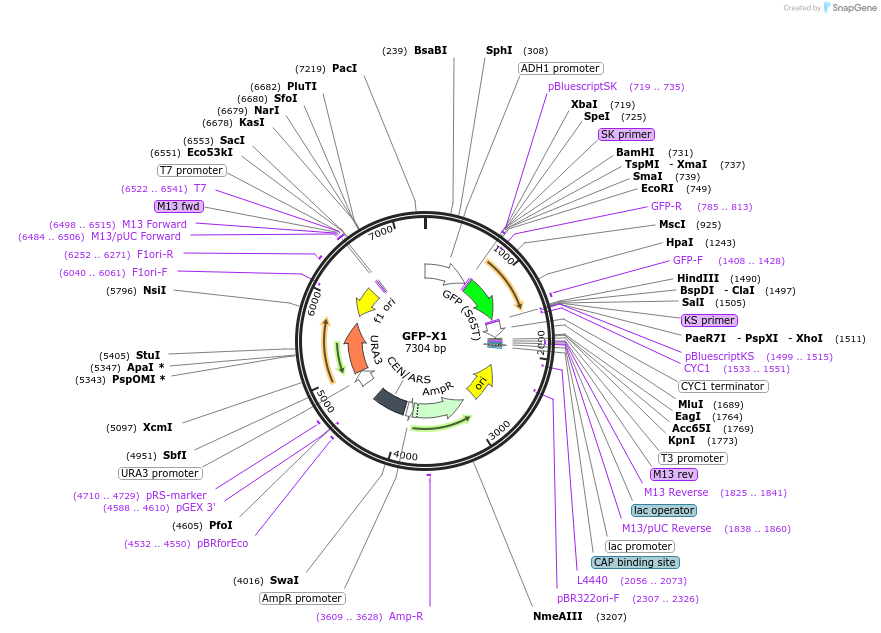GFP-X1
(Plasmid
#115566)
-
PurposeGFP tethered to a single repeat of the Gcn5 consensus motif
-
Depositing Lab
-
Sequence Information
Ordering
| Item | Catalog # | Description | Quantity | Price (USD) | |
|---|---|---|---|---|---|
| Plasmid | 115566 | Standard format: Plasmid sent in bacteria as agar stab | 1 | $89 | |
Backbone
-
Vector backbonepRS406-ADH1/CYC1
- Total vector size (bp) 7304
-
Modifications to backboneInserted multiple cloning site of pRS316
-
Vector typeBacterial Expression, Yeast Expression
-
Selectable markersURA3
Growth in Bacteria
-
Bacterial Resistance(s)Ampicillin, 100 μg/mL
-
Growth Temperature37°C
-
Growth Strain(s)DH5alpha
-
Copy numberLow Copy
Gene/Insert
-
Gene/Insert nameGreen Fluorescent Protein
-
Alt nameGFP
-
SpeciesSynthetic
-
Insert Size (bp)735
-
MutationSingle Gcn5 consensus motif repeat tethered to C-term of GFP
- Promoter ADH1
Cloning Information
- Cloning method Restriction Enzyme
- 5′ cloning site EcoRI (not destroyed)
- 3′ cloning site HindIII (not destroyed)
- 5′ sequencing primer TAATGAGCAACGGTATACGG
- 3′ sequencing primer AATGTTACATGCGTACACGC
- (Common Sequencing Primers)
Terms and Licenses
-
Academic/Nonprofit Terms
-
Industry Terms
- Not Available to Industry
Trademarks:
- Zeocin® is an InvivoGen trademark.
Depositor Comments
Please visit https://www.biorxiv.org/content/10.1101/345637v1 for bioRxiv preprint.
These plasmids were created by your colleagues. Please acknowledge the Principal Investigator, cite the article in which the plasmids were described, and include Addgene in the Materials and Methods of your future publications.
-
For your Materials & Methods section:
GFP-X1 was a gift from Michael Downey (Addgene plasmid # 115566 ; http://n2t.net/addgene:115566 ; RRID:Addgene_115566) -
For your References section:
A synthetic non-histone substrate to study substrate targeting by the Gcn5 HAT and sirtuin HDACs. Rossl A, Denoncourt A, Lin MS, Downey M. J Biol Chem. 2019 Apr 19;294(16):6227-6239. doi: 10.1074/jbc.RA118.006051. Epub 2019 Feb 25. 10.1074/jbc.RA118.006051 PubMed 30804216



